Take Your Edges to the Next Level: Decorative Woodworking Router Techniques
Woodworking Router Techniques: Woodworking is a craft that’s stood the test of time, blending function and beauty effortlessly. Among the variety of tools available to woodworkers, the router shines as one of the most versatile. It can transform a plain piece of wood into something truly artistic. In this article, we’re diving into 10 top decorative woodworking router techniques that can take your craftsmanship to the next level.

👉 Click here to unlock 16,000+ DIY woodworking plans now
Top 10 Decorative Woodworking Router Techniques
1. Edge Profiling
Edge profiling is the bread and butter of decorative router techniques. It involves using different router bits to shape the edges of wood pieces, giving them a bit of flair. Common profiles like beading, coves, and chamfers can elevate the look of furniture, cabinets, and more.
2. Dovetail Joinery
Dovetail joints are the gold standard in woodworking for strength and style. With a router, making precise dovetail joints is a breeze. Using dovetail bits, you can create interlocking joints that add both durability and elegance to drawers, boxes, and other wooden projects.
3. Fluting
Fluting involves carving parallel grooves into the surface of wood, creating a beautiful pattern. Using a fluting bit with your router, you can add a touch of sophistication to table legs, columns, and other wooden elements. It transforms them into striking features that draw the eye.
4. Inlay and Mortise
Inlaying different materials like metal, plastic, or contrasting wood into a wooden surface adds intricate detailing. A router equipped with an inlay kit lets you create precise pockets and mortises, making it easy to embed decorative elements. This technique is great for tabletops, drawer fronts, and panels.
5. Router Carving
Router carving lets you sculpt intricate designs and patterns into wood surfaces. Using a plunge router and carving bits, you can unleash your creativity and create beautiful reliefs and 3D designs on furniture and other wooden projects.
6. Box Joint Construction
Box joints, or finger joints, are a stylish way to join wood pieces at right angles. With a router, a box joint jig, and a straight bit, you can make tight-fitting, interlocking fingers. This adds both strength and visual interest to boxes, drawers, and cabinets.
7. V-Grooving
V-grooving carves V-shaped grooves into the surface of wood, offering a decorative touch. This technique can create intricate designs, borders, and even lettering. A V-groove router bit lets you achieve precision and depth, making it a great tool for enhancing various projects.
8. Rabbeting
Rabbeting involves cutting a step or recess along the edge of a wood piece. It’s handy for inset panels, reinforcing joints, or fitting glass or other materials. A rabbeting bit lets you make clean and precise rabbets, expanding your design possibilities.
9. Raised Panel Doors
Raised panel doors bring a classic touch to cabinets and furniture. With a router and panel-raising bit, you can create elegant profiles on panel edges, giving them a raised look. This adds depth and visual appeal to doors, providing a timeless, refined finish.
10. Template Routing
Template routing uses a template to guide your router along a specific path, helping you create consistent and repeatable shapes. It’s useful for producing identical pieces and intricate patterns. Template routing can be applied to make decorative moldings, detailed patterns, and complex joinery.
Conclusion: Woodworking Router Techniques
Mastering decorative woodworking requires a mix of skill, creativity, and the right tools. The router, with its wide range of bits and capabilities, can elevate your woodworking projects. By incorporating these 10 decorative router techniques into your toolbox, you can unlock new possibilities and take your craftsmanship to new heights. You’ll be able to transform every piece of wood into something unique and visually stunning.
I hope this article on Woodworking Router Techniques has been helpful. If you have any further questions, please feel free to leave a comment below.
👉 Click here to unlock 16,000+ DIY woodworking plans now
